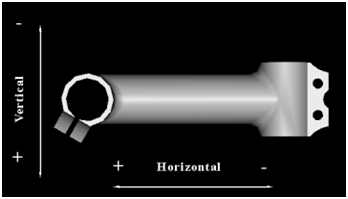Stiffness
Stiffness is defined as the load to deflection
ratio. The
loading condition was a combined mode,
meaning that a +/- horizontal/vertical load was
applied concurrent with a small bending moment
(load was applied 85 mm off of the handlebar
clamp centerline). This combined mode is
consistent with how stems are loaded during any
out of the saddle effort such as climbing or
sprinting.

The load was varied using an air cylinder in
5 psi increments as adjusted through an analog
air pressure regulator (model). Using
specifications provided by the air cylinder
manufacturer, the air pressure values could be
converted to a load. Deflections were
measured along the same axis as the load was
applied using a dial indicator.
At each stage of the durability testing, static
stiffness measurements were made. The many
data points taken allows for a statistically
better measurement as random errors associated
with manually adjusting air pressure or reading
the dial indicator were minimized.
Although the combined loading produces a
rotational/torsional component of displacement,
only the translational movement along the axis
of the applied load was measured.
Consequently, the stiffness measurements that
are reported are not entirely representative of
the physical phenomena at work – it is a
simplification that is extremely repeatable,
however.
The raw data was averaged, plotted
two-dimensionally, and then linearly regressed
(a straight line was fit to the data). The
resulting slope of the load-deflection curve
represented the stiffness of the stem specimen.
Durability
Using the same two loading configurations in the
static stiffness tests described above, the
loads were cycled in the positive and negative
directions according to the following schedule:
